automatic transmission MINI Paceman 2015 Owner's Manual
[x] Cancel search | Manufacturer: MINI, Model Year: 2015, Model line: Paceman, Model: MINI Paceman 2015Pages: 223, PDF Size: 5.51 MB
Page 50 of 223
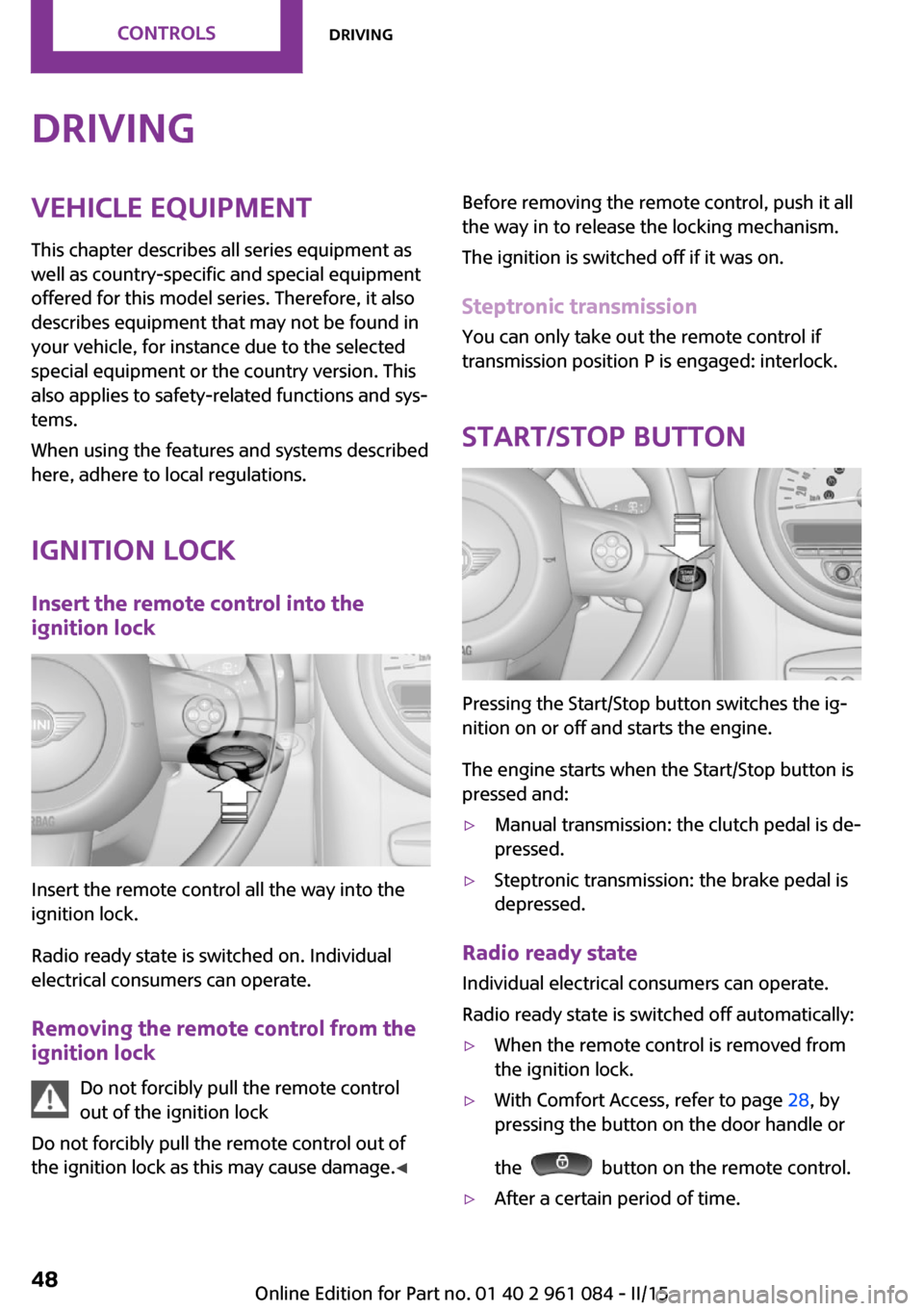
DrivingVehicle equipmentThis chapter describes all series equipment as
well as country-specific and special equipment
offered for this model series. Therefore, it also
describes equipment that may not be found in
your vehicle, for instance due to the selected
special equipment or the country version. This
also applies to safety-related functions and sys‐
tems.
When using the features and systems described
here, adhere to local regulations.
Ignition lock
Insert the remote control into the
ignition lock
Insert the remote control all the way into the
ignition lock.
Radio ready state is switched on. Individual
electrical consumers can operate.
Removing the remote control from the
ignition lock
Do not forcibly pull the remote control
out of the ignition lock
Do not forcibly pull the remote control out of
the ignition lock as this may cause damage. ◀
Before removing the remote control, push it all
the way in to release the locking mechanism.
The ignition is switched off if it was on.
Steptronic transmission You can only take out the remote control if
transmission position P is engaged: interlock.
Start/Stop button
Pressing the Start/Stop button switches the ig‐
nition on or off and starts the engine.
The engine starts when the Start/Stop button is
pressed and:
▷Manual transmission: the clutch pedal is de‐
pressed.▷Steptronic transmission: the brake pedal is
depressed.
Radio ready state
Individual electrical consumers can operate.
Radio ready state is switched off automatically:
▷When the remote control is removed from
the ignition lock.▷With Comfort Access, refer to page 28, by
pressing the button on the door handle or
the
button on the remote control.
▷After a certain period of time.Seite 48CONTROLSDriving48
Online Edition for Part no. 01 40 2 961 084 - II/15
Page 51 of 223
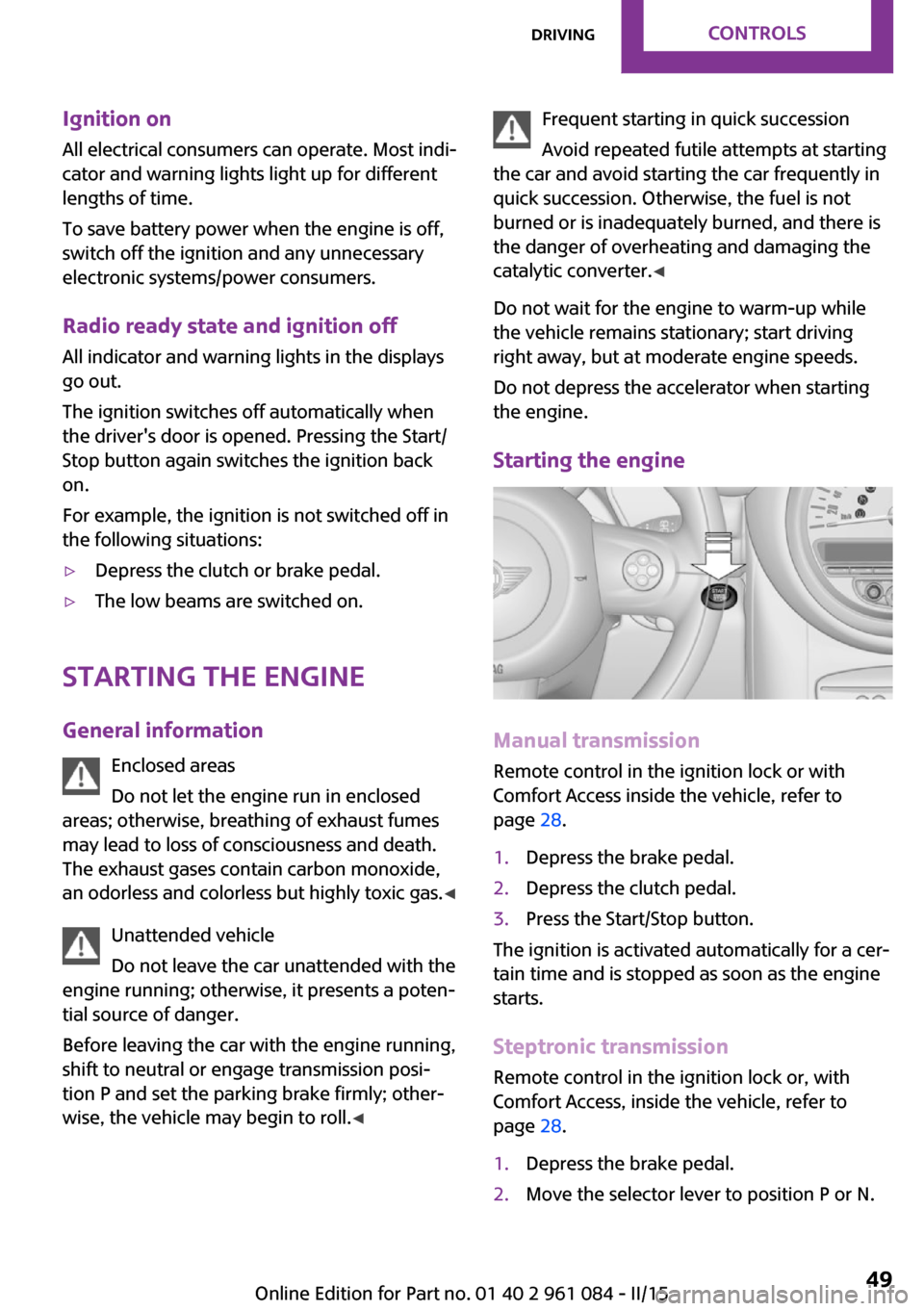
Ignition onAll electrical consumers can operate. Most indi‐
cator and warning lights light up for different
lengths of time.
To save battery power when the engine is off,
switch off the ignition and any unnecessary electronic systems/power consumers.
Radio ready state and ignition off All indicator and warning lights in the displays
go out.
The ignition switches off automatically when
the driver's door is opened. Pressing the Start/
Stop button again switches the ignition back
on.
For example, the ignition is not switched off in
the following situations:▷Depress the clutch or brake pedal.▷The low beams are switched on.
Starting the engine
General information Enclosed areas
Do not let the engine run in enclosed
areas; otherwise, breathing of exhaust fumes
may lead to loss of consciousness and death.
The exhaust gases contain carbon monoxide,
an odorless and colorless but highly toxic gas. ◀
Unattended vehicle
Do not leave the car unattended with the
engine running; otherwise, it presents a poten‐
tial source of danger.
Before leaving the car with the engine running,
shift to neutral or engage transmission posi‐
tion P and set the parking brake firmly; other‐ wise, the vehicle may begin to roll. ◀
Frequent starting in quick succession
Avoid repeated futile attempts at starting
the car and avoid starting the car frequently in
quick succession. Otherwise, the fuel is not
burned or is inadequately burned, and there is
the danger of overheating and damaging the
catalytic converter. ◀
Do not wait for the engine to warm-up while
the vehicle remains stationary; start driving
right away, but at moderate engine speeds.
Do not depress the accelerator when starting
the engine.
Starting the engine
Manual transmission
Remote control in the ignition lock or with
Comfort Access inside the vehicle, refer to
page 28.
1.Depress the brake pedal.2.Depress the clutch pedal.3.Press the Start/Stop button.
The ignition is activated automatically for a cer‐
tain time and is stopped as soon as the engine
starts.
Steptronic transmission
Remote control in the ignition lock or, with
Comfort Access, inside the vehicle, refer to
page 28.
1.Depress the brake pedal.2.Move the selector lever to position P or N.Seite 49DrivingCONTROLS49
Online Edition for Part no. 01 40 2 961 084 - II/15
Page 52 of 223
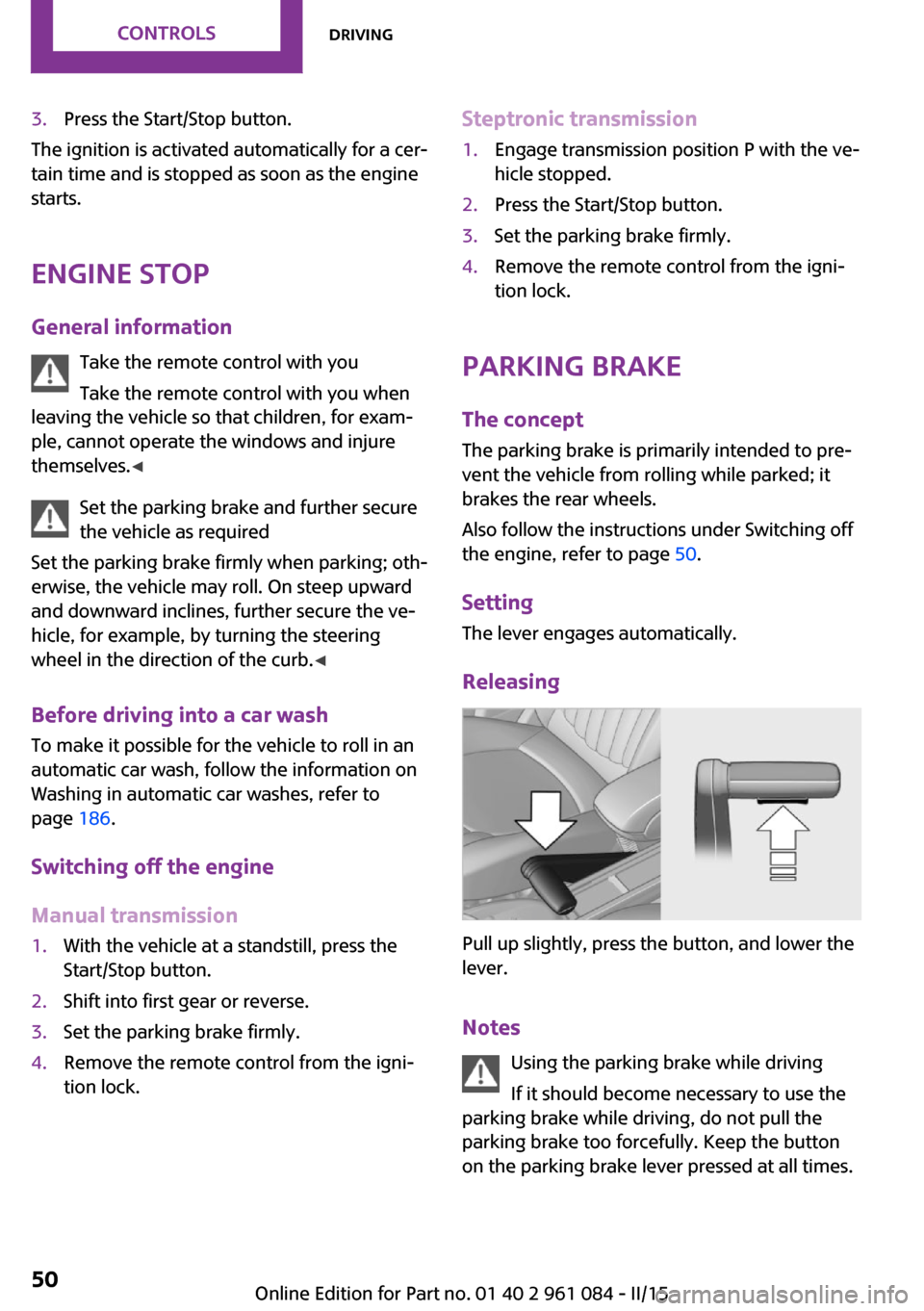
3.Press the Start/Stop button.
The ignition is activated automatically for a cer‐
tain time and is stopped as soon as the engine
starts.
Engine stop
General information Take the remote control with you
Take the remote control with you when
leaving the vehicle so that children, for exam‐
ple, cannot operate the windows and injure
themselves. ◀
Set the parking brake and further secure
the vehicle as required
Set the parking brake firmly when parking; oth‐
erwise, the vehicle may roll. On steep upward
and downward inclines, further secure the ve‐
hicle, for example, by turning the steering
wheel in the direction of the curb. ◀
Before driving into a car wash To make it possible for the vehicle to roll in an
automatic car wash, follow the information on
Washing in automatic car washes, refer to
page 186.
Switching off the engine
Manual transmission
1.With the vehicle at a standstill, press the
Start/Stop button.2.Shift into first gear or reverse.3.Set the parking brake firmly.4.Remove the remote control from the igni‐
tion lock.Steptronic transmission1.Engage transmission position P with the ve‐
hicle stopped.2.Press the Start/Stop button.3.Set the parking brake firmly.4.Remove the remote control from the igni‐
tion lock.
Parking brake
The concept
The parking brake is primarily intended to pre‐
vent the vehicle from rolling while parked; it
brakes the rear wheels.
Also follow the instructions under Switching off
the engine, refer to page 50.
Setting The lever engages automatically.
Releasing
Pull up slightly, press the button, and lower the
lever.
Notes Using the parking brake while driving
If it should become necessary to use the
parking brake while driving, do not pull the
parking brake too forcefully. Keep the button
on the parking brake lever pressed at all times.
Seite 50CONTROLSDriving50
Online Edition for Part no. 01 40 2 961 084 - II/15
Page 57 of 223
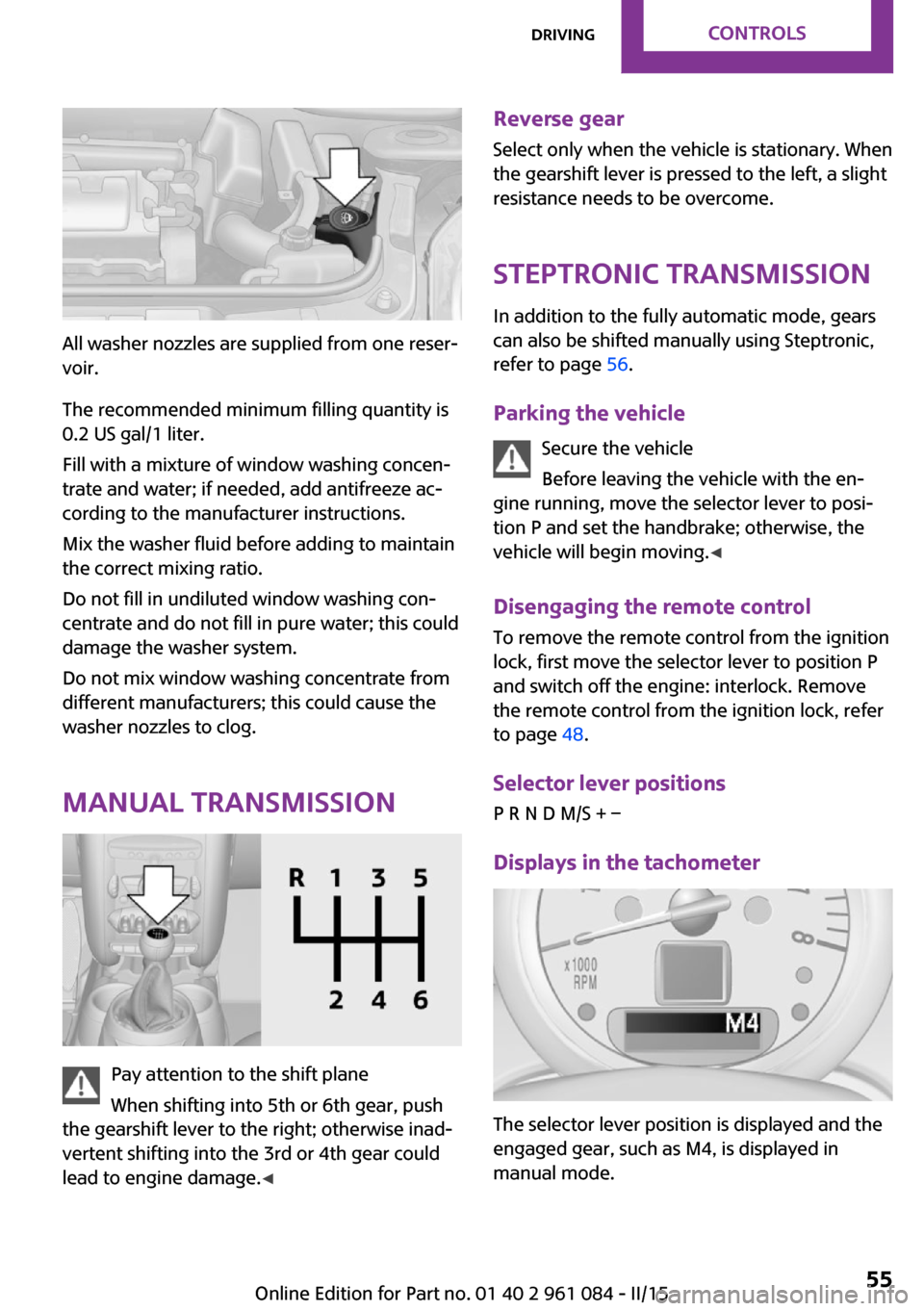
All washer nozzles are supplied from one reser‐
voir.
The recommended minimum filling quantity is
0.2 US gal/1 liter.
Fill with a mixture of window washing concen‐
trate and water; if needed, add antifreeze ac‐
cording to the manufacturer instructions.
Mix the washer fluid before adding to maintain
the correct mixing ratio.
Do not fill in undiluted window washing con‐
centrate and do not fill in pure water; this could
damage the washer system.
Do not mix window washing concentrate from
different manufacturers; this could cause the
washer nozzles to clog.
Manual transmission
Pay attention to the shift plane
When shifting into 5th or 6th gear, push
the gearshift lever to the right; otherwise inad‐
vertent shifting into the 3rd or 4th gear could
lead to engine damage. ◀
Reverse gear
Select only when the vehicle is stationary. When
the gearshift lever is pressed to the left, a slight
resistance needs to be overcome.
Steptronic transmission In addition to the fully automatic mode, gears
can also be shifted manually using Steptronic,
refer to page 56.
Parking the vehicle Secure the vehicle
Before leaving the vehicle with the en‐
gine running, move the selector lever to posi‐
tion P and set the handbrake; otherwise, the
vehicle will begin moving. ◀
Disengaging the remote control
To remove the remote control from the ignition
lock, first move the selector lever to position P
and switch off the engine: interlock. Remove
the remote control from the ignition lock, refer
to page 48.
Selector lever positions
P R N D M/S + –
Displays in the tachometer
The selector lever position is displayed and the
engaged gear, such as M4, is displayed in
manual mode.
Seite 55DrivingCONTROLS55
Online Edition for Part no. 01 40 2 961 084 - II/15
Page 114 of 223
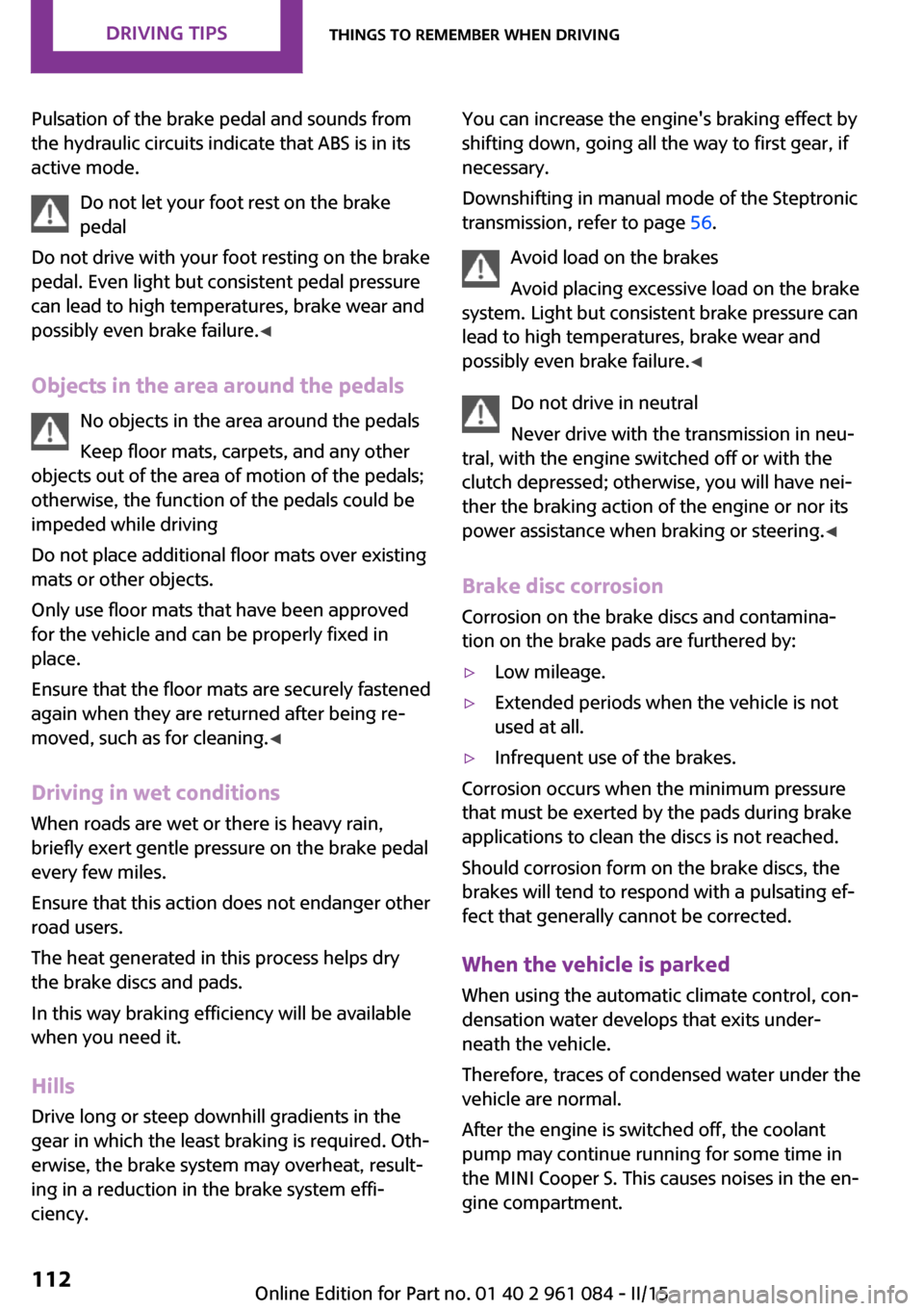
Pulsation of the brake pedal and sounds from
the hydraulic circuits indicate that ABS is in its
active mode.
Do not let your foot rest on the brake
pedal
Do not drive with your foot resting on the brake
pedal. Even light but consistent pedal pressure
can lead to high temperatures, brake wear and
possibly even brake failure. ◀
Objects in the area around the pedals No objects in the area around the pedals
Keep floor mats, carpets, and any other
objects out of the area of motion of the pedals;
otherwise, the function of the pedals could be
impeded while driving
Do not place additional floor mats over existing
mats or other objects.
Only use floor mats that have been approved
for the vehicle and can be properly fixed in
place.
Ensure that the floor mats are securely fastened
again when they are returned after being re‐
moved, such as for cleaning. ◀
Driving in wet conditions
When roads are wet or there is heavy rain, briefly exert gentle pressure on the brake pedal
every few miles.
Ensure that this action does not endanger other
road users.
The heat generated in this process helps dry
the brake discs and pads.
In this way braking efficiency will be available
when you need it.
HillsDrive long or steep downhill gradients in the
gear in which the least braking is required. Oth‐
erwise, the brake system may overheat, result‐
ing in a reduction in the brake system effi‐
ciency.You can increase the engine's braking effect by
shifting down, going all the way to first gear, if
necessary.
Downshifting in manual mode of the Steptronic
transmission, refer to page 56.
Avoid load on the brakes
Avoid placing excessive load on the brake
system. Light but consistent brake pressure can
lead to high temperatures, brake wear and
possibly even brake failure. ◀
Do not drive in neutral
Never drive with the transmission in neu‐
tral, with the engine switched off or with the
clutch depressed; otherwise, you will have nei‐
ther the braking action of the engine or nor its
power assistance when braking or steering. ◀
Brake disc corrosion Corrosion on the brake discs and contamina‐
tion on the brake pads are furthered by:▷Low mileage.▷Extended periods when the vehicle is not
used at all.▷Infrequent use of the brakes.
Corrosion occurs when the minimum pressure
that must be exerted by the pads during brake
applications to clean the discs is not reached.
Should corrosion form on the brake discs, the
brakes will tend to respond with a pulsating ef‐
fect that generally cannot be corrected.
When the vehicle is parked
When using the automatic climate control, con‐
densation water develops that exits under‐
neath the vehicle.
Therefore, traces of condensed water under the
vehicle are normal.
After the engine is switched off, the coolant
pump may continue running for some time in
the MINI Cooper S. This causes noises in the en‐
gine compartment.
Seite 112DRIVING TIPSThings to remember when driving112
Online Edition for Part no. 01 40 2 961 084 - II/15
Page 187 of 223
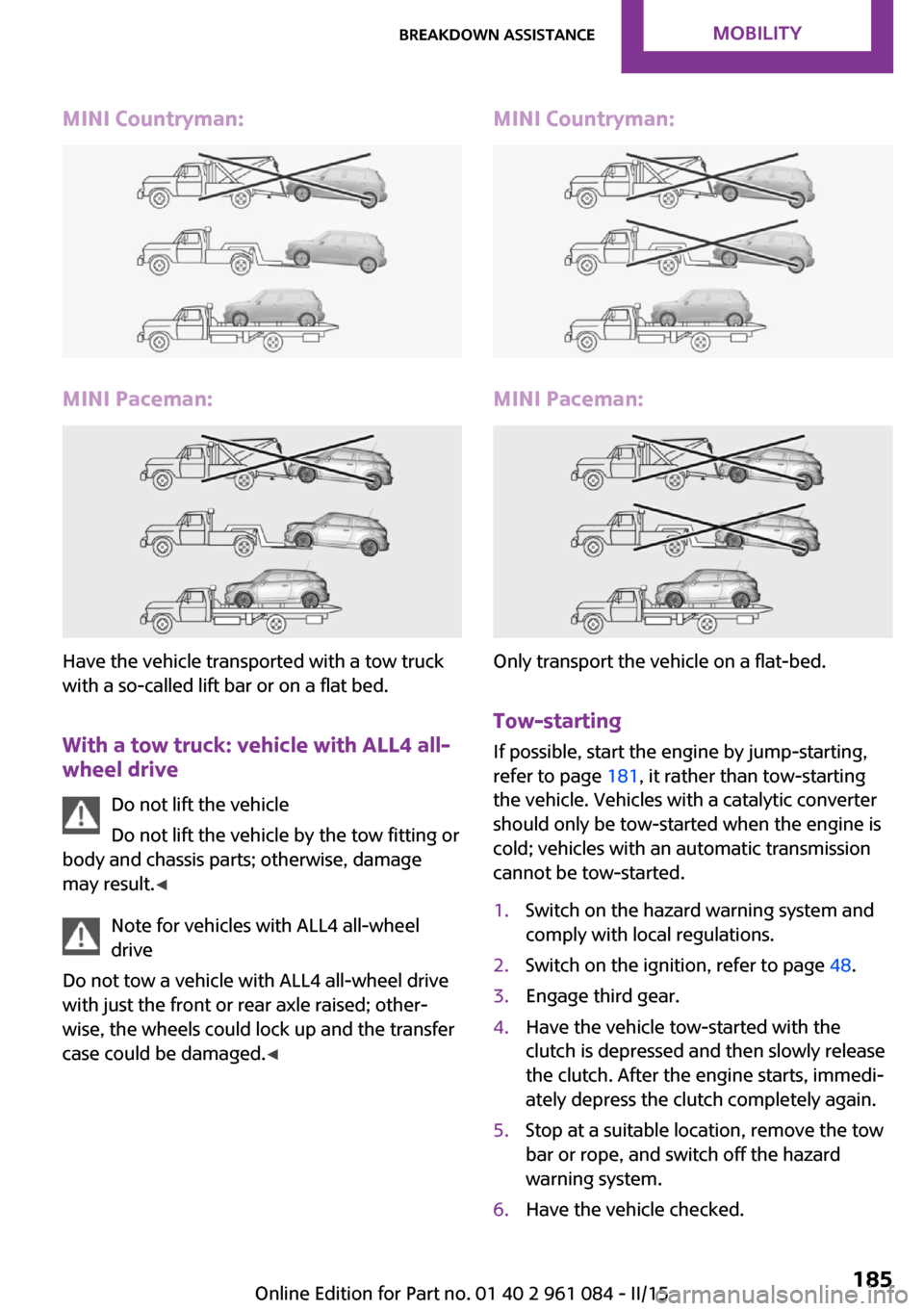
MINI Countryman:
MINI Paceman:
Have the vehicle transported with a tow truck
with a so-called lift bar or on a flat bed.
With a tow truck: vehicle with ALL4 all-wheel drive
Do not lift the vehicle
Do not lift the vehicle by the tow fitting or
body and chassis parts; otherwise, damage
may result. ◀
Note for vehicles with ALL4 all-wheel
drive
Do not tow a vehicle with ALL4 all-wheel drive
with just the front or rear axle raised; other‐
wise, the wheels could lock up and the transfer
case could be damaged. ◀
MINI Countryman:
MINI Paceman:
Only transport the vehicle on a flat-bed.
Tow-starting
If possible, start the engine by jump-starting,
refer to page 181, it rather than tow-starting
the vehicle. Vehicles with a catalytic converter
should only be tow-started when the engine is
cold; vehicles with an automatic transmission
cannot be tow-started.
1.Switch on the hazard warning system and
comply with local regulations.2.Switch on the ignition, refer to page 48.3.Engage third gear.4.Have the vehicle tow-started with the
clutch is depressed and then slowly release
the clutch. After the engine starts, immedi‐
ately depress the clutch completely again.5.Stop at a suitable location, remove the tow
bar or rope, and switch off the hazard
warning system.6.Have the vehicle checked.Seite 185Breakdown assistanceMOBILITY185
Online Edition for Part no. 01 40 2 961 084 - II/15
Page 202 of 223
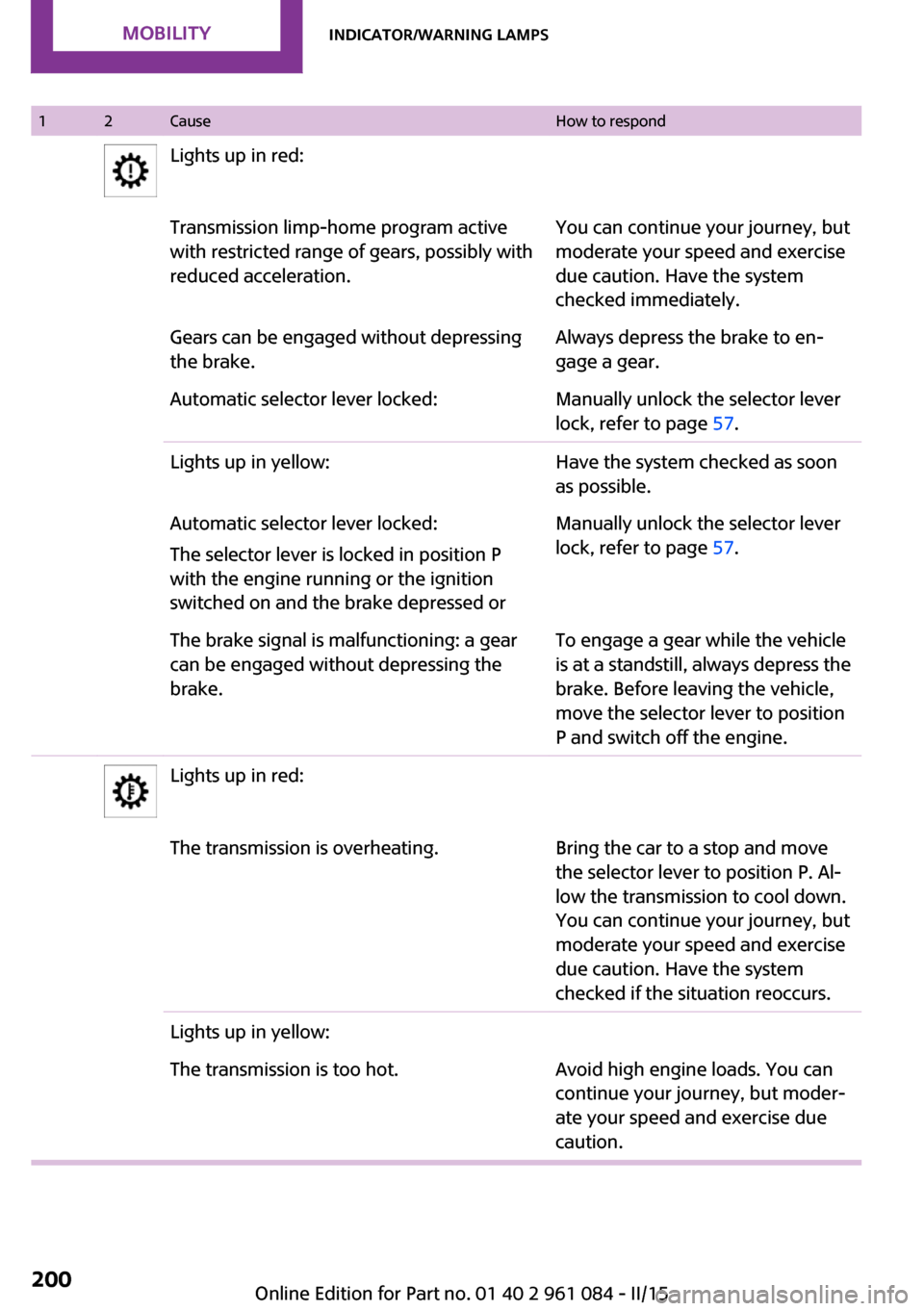
12CauseHow to respondLights up in red:Transmission limp-home program active
with restricted range of gears, possibly with
reduced acceleration.You can continue your journey, but
moderate your speed and exercise
due caution. Have the system
checked immediately.Gears can be engaged without depressing
the brake.Always depress the brake to en‐
gage a gear.Automatic selector lever locked:Manually unlock the selector lever
lock, refer to page 57.Lights up in yellow:Have the system checked as soon
as possible.Automatic selector lever locked:
The selector lever is locked in position P
with the engine running or the ignition
switched on and the brake depressed orManually unlock the selector lever
lock, refer to page 57.The brake signal is malfunctioning: a gear
can be engaged without depressing the
brake.To engage a gear while the vehicle
is at a standstill, always depress the
brake. Before leaving the vehicle,
move the selector lever to position
P and switch off the engine.Lights up in red:The transmission is overheating.Bring the car to a stop and move
the selector lever to position P. Al‐
low the transmission to cool down.
You can continue your journey, but
moderate your speed and exercise
due caution. Have the system
checked if the situation reoccurs.Lights up in yellow:The transmission is too hot.Avoid high engine loads. You can
continue your journey, but moder‐
ate your speed and exercise due
caution.Seite 200MOBILITYIndicator/warning lamps200
Online Edition for Part no. 01 40 2 961 084 - II/15
Page 212 of 223
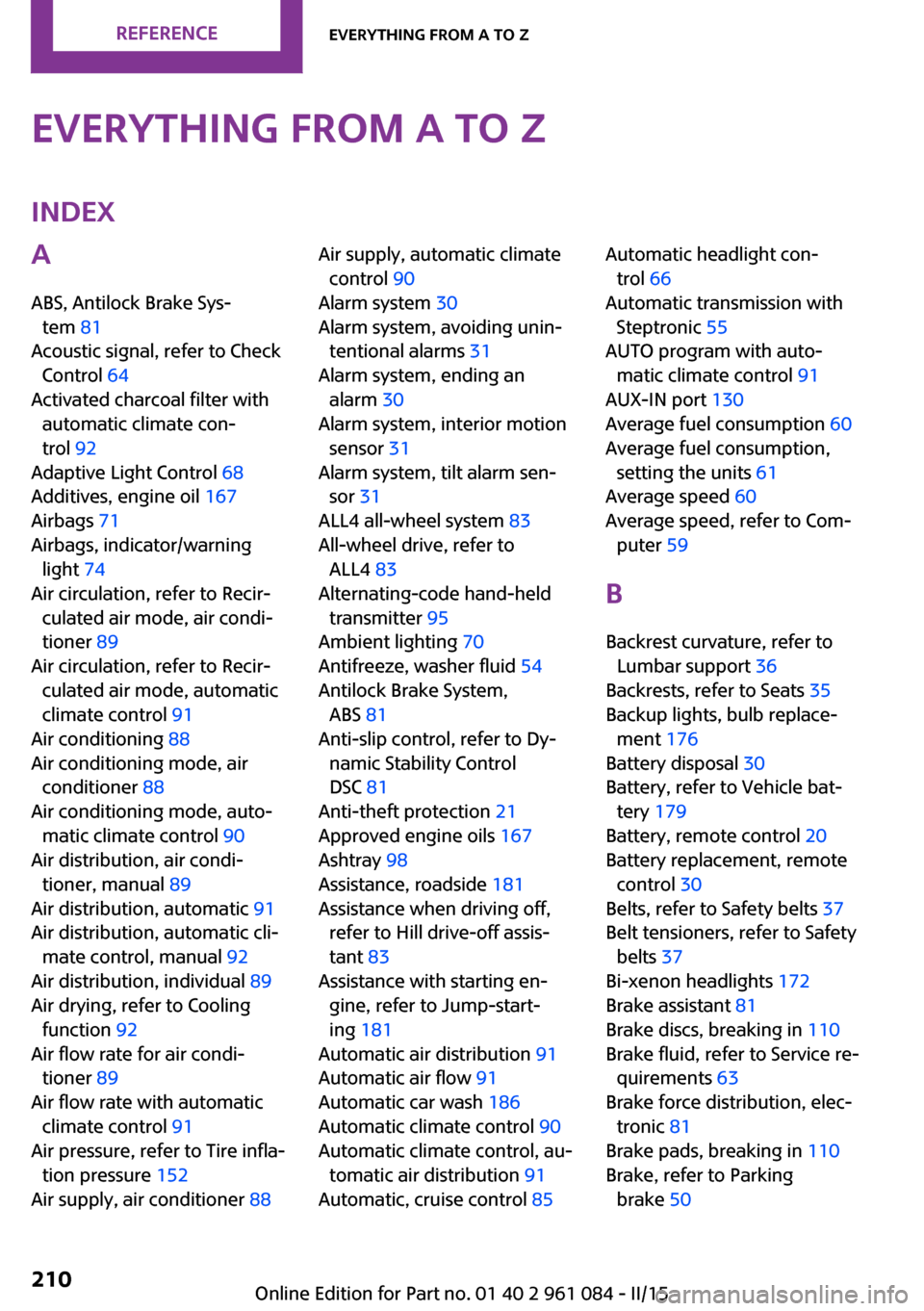
Everything from A to ZIndexA
ABS, Antilock Brake Sys‐ tem 81
Acoustic signal, refer to Check Control 64
Activated charcoal filter with automatic climate con‐
trol 92
Adaptive Light Control 68
Additives, engine oil 167
Airbags 71
Airbags, indicator/warning light 74
Air circulation, refer to Recir‐ culated air mode, air condi‐
tioner 89
Air circulation, refer to Recir‐ culated air mode, automatic
climate control 91
Air conditioning 88
Air conditioning mode, air conditioner 88
Air conditioning mode, auto‐ matic climate control 90
Air distribution, air condi‐ tioner, manual 89
Air distribution, automatic 91
Air distribution, automatic cli‐ mate control, manual 92
Air distribution, individual 89
Air drying, refer to Cooling function 92
Air flow rate for air condi‐ tioner 89
Air flow rate with automatic climate control 91
Air pressure, refer to Tire infla‐ tion pressure 152
Air supply, air conditioner 88 Air supply, automatic climate
control 90
Alarm system 30
Alarm system, avoiding unin‐ tentional alarms 31
Alarm system, ending an alarm 30
Alarm system, interior motion sensor 31
Alarm system, tilt alarm sen‐ sor 31
ALL4 all-wheel system 83
All-wheel drive, refer to ALL4 83
Alternating-code hand-held transmitter 95
Ambient lighting 70
Antifreeze, washer fluid 54
Antilock Brake System, ABS 81
Anti-slip control, refer to Dy‐ namic Stability Control
DSC 81
Anti-theft protection 21
Approved engine oils 167
Ashtray 98
Assistance, roadside 181
Assistance when driving off, refer to Hill drive-off assis‐
tant 83
Assistance with starting en‐ gine, refer to Jump-start‐
ing 181
Automatic air distribution 91
Automatic air flow 91
Automatic car wash 186
Automatic climate control 90
Automatic climate control, au‐ tomatic air distribution 91
Automatic, cruise control 85 Automatic headlight con‐
trol 66
Automatic transmission with Steptronic 55
AUTO program with auto‐ matic climate control 91
AUX-IN port 130
Average fuel consumption 60
Average fuel consumption, setting the units 61
Average speed 60
Average speed, refer to Com‐ puter 59
B Backrest curvature, refer to Lumbar support 36
Backrests, refer to Seats 35
Backup lights, bulb replace‐ ment 176
Battery disposal 30
Battery, refer to Vehicle bat‐ tery 179
Battery, remote control 20
Battery replacement, remote control 30
Belts, refer to Safety belts 37
Belt tensioners, refer to Safety belts 37
Bi-xenon headlights 172
Brake assistant 81
Brake discs, breaking in 110
Brake fluid, refer to Service re‐ quirements 63
Brake force distribution, elec‐ tronic 81
Brake pads, breaking in 110
Brake, refer to Parking brake 50 Seite 210REFERENCEEverything from A to Z210
Online Edition for Part no. 01 40 2 961 084 - II/15
Page 217 of 223
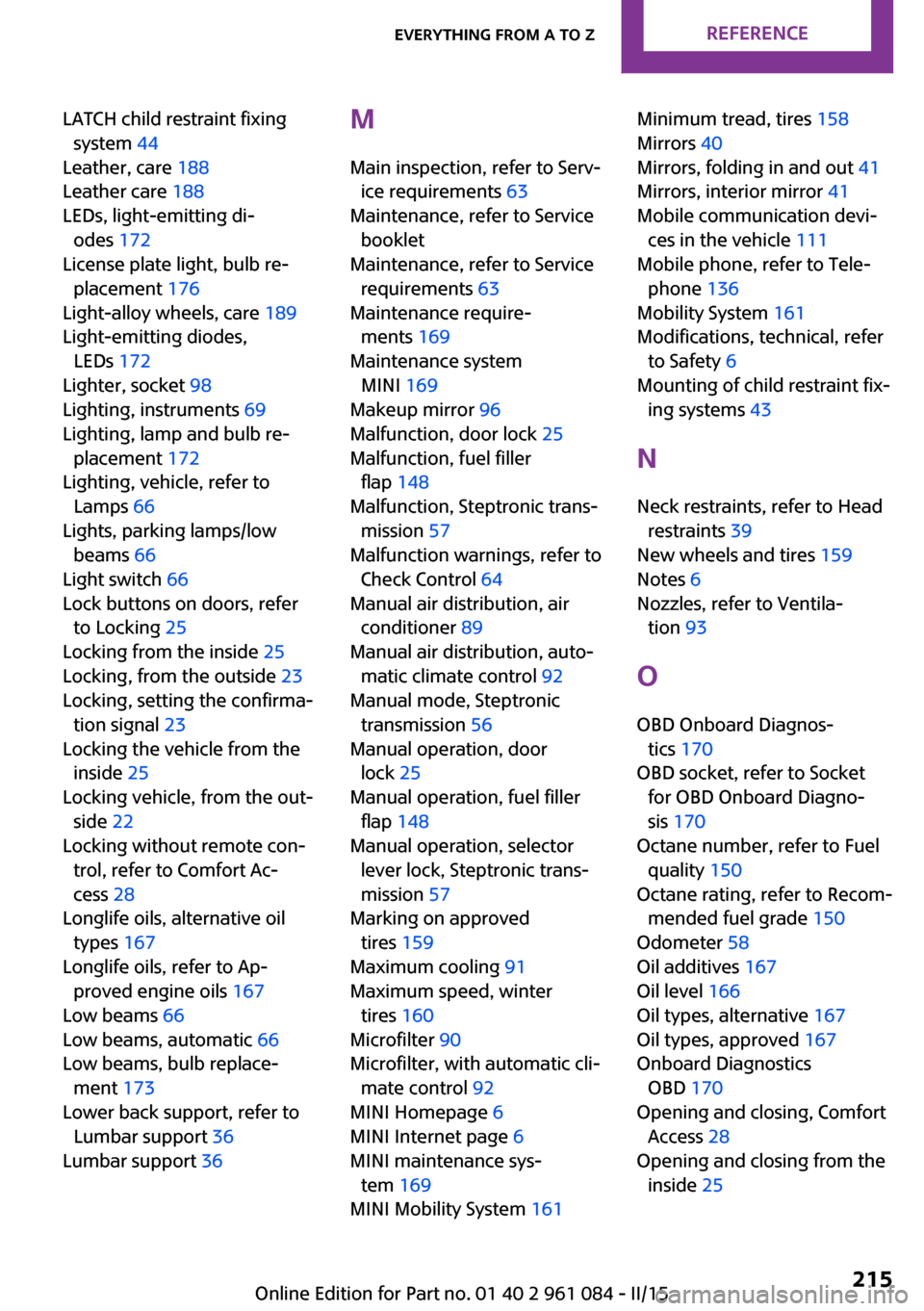
LATCH child restraint fixingsystem 44
Leather, care 188
Leather care 188
LEDs, light-emitting di‐ odes 172
License plate light, bulb re‐ placement 176
Light-alloy wheels, care 189
Light-emitting diodes, LEDs 172
Lighter, socket 98
Lighting, instruments 69
Lighting, lamp and bulb re‐ placement 172
Lighting, vehicle, refer to Lamps 66
Lights, parking lamps/low beams 66
Light switch 66
Lock buttons on doors, refer to Locking 25
Locking from the inside 25
Locking, from the outside 23
Locking, setting the confirma‐ tion signal 23
Locking the vehicle from the inside 25
Locking vehicle, from the out‐ side 22
Locking without remote con‐ trol, refer to Comfort Ac‐
cess 28
Longlife oils, alternative oil types 167
Longlife oils, refer to Ap‐ proved engine oils 167
Low beams 66
Low beams, automatic 66
Low beams, bulb replace‐ ment 173
Lower back support, refer to Lumbar support 36
Lumbar support 36 M
Main inspection, refer to Serv‐ ice requirements 63
Maintenance, refer to Service booklet
Maintenance, refer to Service requirements 63
Maintenance require‐ ments 169
Maintenance system MINI 169
Makeup mirror 96
Malfunction, door lock 25
Malfunction, fuel filler flap 148
Malfunction, Steptronic trans‐ mission 57
Malfunction warnings, refer to Check Control 64
Manual air distribution, air conditioner 89
Manual air distribution, auto‐ matic climate control 92
Manual mode, Steptronic transmission 56
Manual operation, door lock 25
Manual operation, fuel filler flap 148
Manual operation, selector lever lock, Steptronic trans‐
mission 57
Marking on approved tires 159
Maximum cooling 91
Maximum speed, winter tires 160
Microfilter 90
Microfilter, with automatic cli‐ mate control 92
MINI Homepage 6
MINI Internet page 6
MINI maintenance sys‐ tem 169
MINI Mobility System 161 Minimum tread, tires 158
Mirrors 40
Mirrors, folding in and out 41
Mirrors, interior mirror 41
Mobile communication devi‐ ces in the vehicle 111
Mobile phone, refer to Tele‐ phone 136
Mobility System 161
Modifications, technical, refer to Safety 6
Mounting of child restraint fix‐ ing systems 43
N Neck restraints, refer to Head restraints 39
New wheels and tires 159
Notes 6
Nozzles, refer to Ventila‐ tion 93
O
OBD Onboard Diagnos‐ tics 170
OBD socket, refer to Socket for OBD Onboard Diagno‐
sis 170
Octane number, refer to Fuel quality 150
Octane rating, refer to Recom‐ mended fuel grade 150
Odometer 58
Oil additives 167
Oil level 166
Oil types, alternative 167
Oil types, approved 167
Onboard Diagnostics OBD 170
Opening and closing, Comfort Access 28
Opening and closing from the inside 25 Seite 215Everything from A to ZREFERENCE215
Online Edition for Part no. 01 40 2 961 084 - II/15
Page 220 of 223
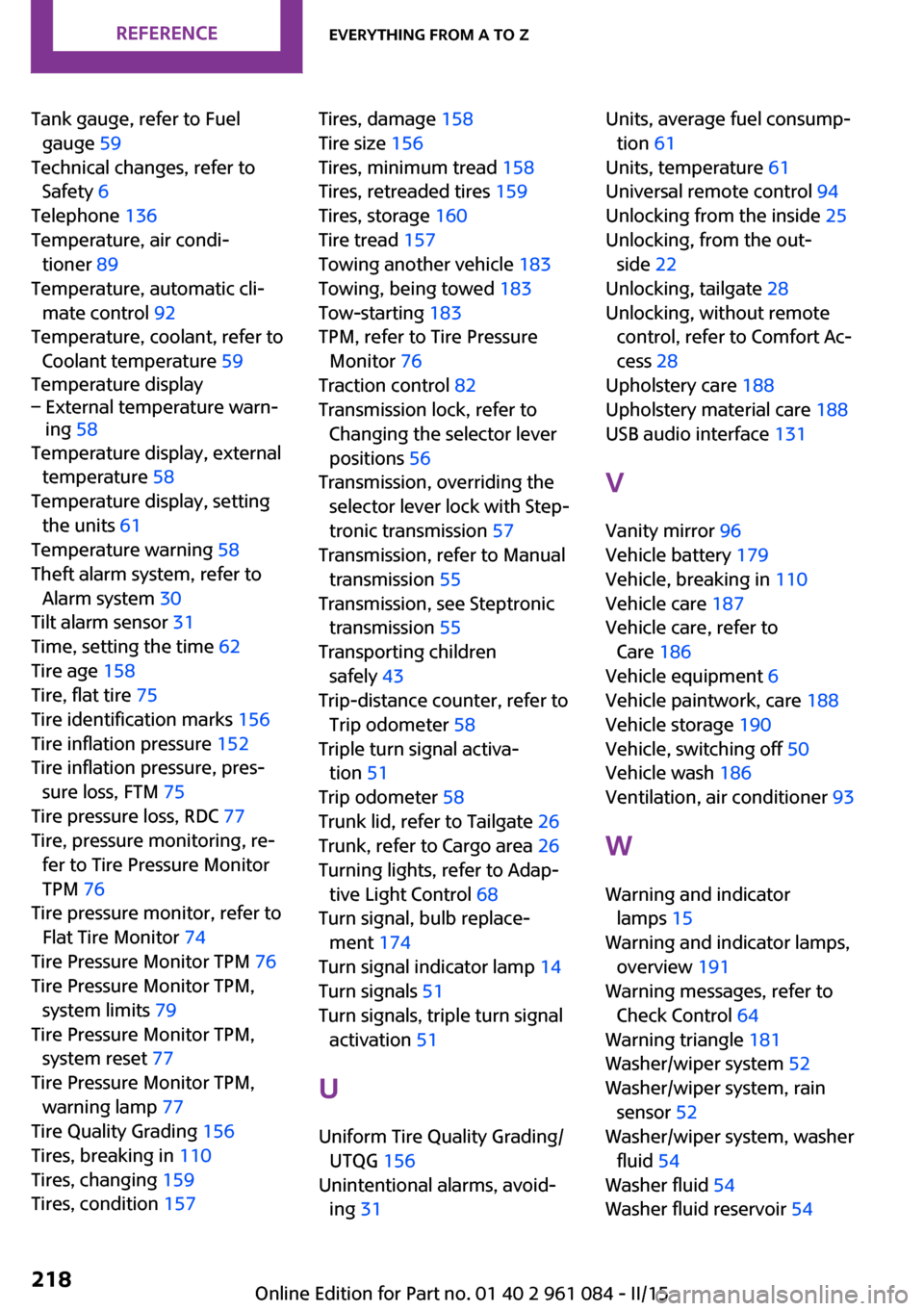
Tank gauge, refer to Fuelgauge 59
Technical changes, refer to Safety 6
Telephone 136
Temperature, air condi‐ tioner 89
Temperature, automatic cli‐ mate control 92
Temperature, coolant, refer to Coolant temperature 59
Temperature display– External temperature warn‐
ing 58
Temperature display, external
temperature 58
Temperature display, setting the units 61
Temperature warning 58
Theft alarm system, refer to Alarm system 30
Tilt alarm sensor 31
Time, setting the time 62
Tire age 158
Tire, flat tire 75
Tire identification marks 156
Tire inflation pressure 152
Tire inflation pressure, pres‐ sure loss, FTM 75
Tire pressure loss, RDC 77
Tire, pressure monitoring, re‐ fer to Tire Pressure Monitor
TPM 76
Tire pressure monitor, refer to Flat Tire Monitor 74
Tire Pressure Monitor TPM 76
Tire Pressure Monitor TPM, system limits 79
Tire Pressure Monitor TPM, system reset 77
Tire Pressure Monitor TPM, warning lamp 77
Tire Quality Grading 156
Tires, breaking in 110
Tires, changing 159
Tires, condition 157
Tires, damage 158
Tire size 156
Tires, minimum tread 158
Tires, retreaded tires 159
Tires, storage 160
Tire tread 157
Towing another vehicle 183
Towing, being towed 183
Tow-starting 183
TPM, refer to Tire Pressure Monitor 76
Traction control 82
Transmission lock, refer to Changing the selector lever
positions 56
Transmission, overriding the selector lever lock with Step‐
tronic transmission 57
Transmission, refer to Manual transmission 55
Transmission, see Steptronic transmission 55
Transporting children safely 43
Trip-distance counter, refer to Trip odometer 58
Triple turn signal activa‐ tion 51
Trip odometer 58
Trunk lid, refer to Tailgate 26
Trunk, refer to Cargo area 26
Turning lights, refer to Adap‐ tive Light Control 68
Turn signal, bulb replace‐ ment 174
Turn signal indicator lamp 14
Turn signals 51
Turn signals, triple turn signal activation 51
U
Uniform Tire Quality Grading/ UTQG 156
Unintentional alarms, avoid‐ ing 31 Units, average fuel consump‐
tion 61
Units, temperature 61
Universal remote control 94
Unlocking from the inside 25
Unlocking, from the out‐ side 22
Unlocking, tailgate 28
Unlocking, without remote control, refer to Comfort Ac‐
cess 28
Upholstery care 188
Upholstery material care 188
USB audio interface 131
V Vanity mirror 96
Vehicle battery 179
Vehicle, breaking in 110
Vehicle care 187
Vehicle care, refer to Care 186
Vehicle equipment 6
Vehicle paintwork, care 188
Vehicle storage 190
Vehicle, switching off 50
Vehicle wash 186
Ventilation, air conditioner 93
W
Warning and indicator lamps 15
Warning and indicator lamps, overview 191
Warning messages, refer to Check Control 64
Warning triangle 181
Washer/wiper system 52
Washer/wiper system, rain sensor 52
Washer/wiper system, washer fluid 54
Washer fluid 54
Washer fluid reservoir 54 Seite 218REFERENCEEverything from A to Z218
Online Edition for Part no. 01 40 2 961 084 - II/15